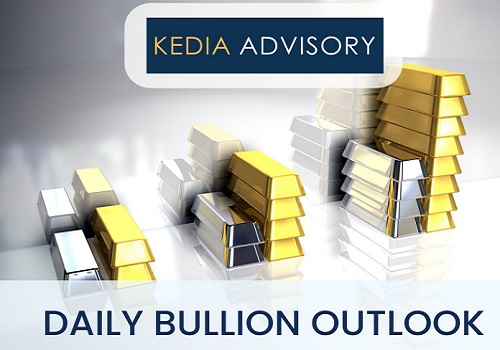Silver trading range for the day is 99585-107915 - Kedia Advisory

Gold
Gold futures declined by 0.72% to settle at 97,874 as investors weighed a mix of weak U.S. economic data and geopolitical developments. A reported phone call between U.S. President Trump and Chinese President Xi stirred speculation, but the lack of details left markets cautious. Economic data painted a gloomy picture: U.S. jobless claims rose to 247K, the highest since October 2024 and above forecasts, while private-sector job growth slumped to just 37K in May, the weakest since March 2023. Additionally, Q1 productivity was revised lower, and the ISM Services PMI showed the first contraction in nearly a year. Trade tensions added further pressure after the U.S. doubled tariffs on steel and aluminium imports, heightening fears of a renewed trade war. On the demand side, global gold demand rose by 1% YoY in Q1 2025 to 1,206 metric tons, fueled by a 170% surge in investment demand, primarily through ETFs and a 14% rise in gold bar demand. However, jewellery demand fell 21% globally, and central bank buying slowed, with purchases down 21% to 243.7 tons. In India, physical demand remained subdued due to high prices and the end of the wedding season, with dealers offering discounts up to $31/oz. Technically, the market is under long liquidation with a notable 11.63% drop in open interest to 15,231 lots. Gold finds support at 97,225, with further downside likely to test 96,580. Resistance is placed at 98,865, and a breakout could push prices toward 99,860.
Trading Ideas:
* Gold trading range for the day is 96580-99860.
* Gold trimmed gains as markets digested mixed U.S. data and Trump–Xi phone call news.
* U.S. jobless claims jumped to 247K, the highest since October 2024, exceeding expectations.
* ISM Services PMI signaled first contraction in nearly a year, dampening economic optimism.
Silver
Silver futures surged by 3.02% to settle at 1,04,443, driven by growing safe-haven demand amid weak U.S. economic data and rising expectations of a Federal Reserve rate cut in September. A slew of disappointing macro indicators reinforced dovish sentiment: weekly jobless claims climbed to 247K, the highest since October 2024, surpassing forecasts; ADP employment data showed only 37K private-sector jobs added in May — the lowest since March 2023; and the ISM Services PMI revealed the sector’s first contraction in nearly a year. Meanwhile, Q1 productivity declined more than initially reported and the trade deficit narrowed on falling imports. Compounding market uncertainty were fresh trade tensions, with the U.S. doubling tariffs on steel and aluminium imports to 50%. On the supply-demand front, silver remains in structural deficit for the fifth consecutive year in 2025, although the shortfall is projected to narrow 21% to 117.6 million troy ounces. Industrial demand remains the key pillar, with silver fabrication expected to surpass 700 million ounces for the first time, supported by green energy sectors. Physical investment demand is forecast to rise 3%, while silver coin and bar demand is projected to rebound 7% after a steep 22% decline in 2024. However, jewellery and silverware demand is set to decline by 6%, led by reduced Indian consumption due to high domestic prices. Technically, the market shows fresh buying interest with open interest rising by 14.54% to 20,560 lots. Silver finds support at 1,02,015 and may test 99,585 if breached. Resistance is seen at 1,06,180, with further upside potential toward 1,07,915.
Trading Ideas:
* Silver trading range for the day is 99585-107915.
* Silver crossed 1,05,000 as weak U.S. data spurred Fed rate cut expectations.
* Weekly jobless claims hit 247K, the highest since October 2024, exceeding forecasts.
* ADP jobs report showed just 37K additions the weakest private job growth since 2023.
Crude oil
Crude oil prices edged higher by 1.04% to settle at 5,442, buoyed by rising demand expectations as the U.S. summer driving season gains momentum, alongside supply disruptions due to wildfires in northern Alberta. The bullish sentiment was reinforced by a sharp decline in U.S. crude inventories, which fell by 4.3 million barrels in the week ending May 30 — the largest drawdown since November 2024 — signaling robust fuel consumption. However, rising gasoline inventories by 5.219 million barrels and distillate stocks by 4.23 thousand barrels suggest potential oversupply in refined products. Supply-side dynamics remain mixed. While U.S. crude output surged to a record 13.488 million barrels per day in March, indicating strong domestic production, Saudi Arabia’s push for an OPEC+ production hike of at least 411,000 bpd in August and possibly September could add further supply pressure. Moreover, Saudi Arabia’s decision to slash July prices for Asian buyers to near four-year lows points to softening regional demand. On the global front, the IEA projects oil demand growth will slow to 650,000 bpd for the remainder of 2025 due to economic challenges and increasing EV adoption, although it has revised its full-year growth estimate slightly higher to 740,000 bpd. Technically, crude oil is showing signs of fresh buying interest with a 7.56% rise in open interest to 6,761 lots. Immediate support is seen at 5,379, with deeper support at 5,316. On the upside, resistance lies at 5,497, and a breakout above that could push prices toward 5,552.
Trading Ideas:
* Crudeoil trading range for the day is 5316-5552.
* Crude oil rises on stronger demand outlook, Alberta wildfires hit oil-sands supply.
* U.S. crude inventories dropped by 4.3 million barrels, the biggest decline since November.
* Saudi Arabia proposes OPEC+ hike of 411,000 bpd in August, possibly extending to September.
Natural gas
Natural gas prices rose modestly by 0.44% to settle at 319.7, supported by a mix of bullish supply and demand dynamics despite a larger-than-expected build in inventories. The U.S. Energy Information Administration (EIA) reported that storage levels increased by 122 billion cubic feet (bcf) for the week ending May 30, significantly above market expectations of 111 bcf. This build takes total gas in storage to 2.598 trillion cubic feet—10% below last year’s levels, but still 4.7% above the five-year average, offering a cushion ahead of the peak summer demand season. Meanwhile, gas flows to major LNG export terminals have declined to 13.8 bcfd so far in June from 15.0 bcfd in May, largely due to seasonal maintenance at facilities such as Cheniere's. On the production side, average output from the Lower 48 states slipped to 104.0 bcfd from 105.2 bcfd in May, and from the March record of 106.3 bcfd, adding a mildly supportive tone to the market. Weather forecasts continue to show warmer-than-usual conditions through mid-June, which could boost cooling demand and help sustain prices. Technically, the market is witnessing short covering, with open interest falling by 6.32% to 13,981 lots while prices edged up. Natural gas finds support at 312.2 and could test 304.6 if this breaks. On the upside, resistance lies at 326.3, with further gains possible toward 332.8.
Trading Ideas:
* Naturalgas trading range for the day is 304.6-332.8.
* Natural gas prices declined after a higher-than-expected 122 bcf storage build last week.
* Total U.S. gas storage rose to 2.598 tcf, exceeding forecasts and seasonal norms.
* Gas stockpiles remain 10% below last year but 4.7% above the five-year average.
Copper
Copper prices climbed 0.52% to settle at 880.2, supported by a mix of persistent supply-side concerns and growing trade tensions that have injected bullish sentiment into the market. Disruptions at Teck Resources' operations in Chile and reduced mining activity at the Kamoa-Kakula project in the Democratic Republic of Congo are expected to strain global supply in the coming months. Adding to the tension, U.S. President Trump’s decision to double tariffs on steel and aluminum imports has triggered speculation that copper might soon face similar trade actions. The ongoing U.S. investigation into copper imports is further fueling uncertainty. Despite this, gains were capped by weak Chinese macroeconomic indicators. Soft manufacturing and services data from China—the world’s top copper consumer—raised demand-side concerns. Still, support came from ongoing inventory outflows on the London Metal Exchange (LME), with stocks dropping to a near one-year low of 143,850 tons after 4,600 tons were delivered out. The 21-day moving average at $9,526 also acted as a price floor. While Chile's copper output rose 13.5% year-on-year in April, the global refined copper market saw a sharp contraction in surplus—from 180,000 tons in February to just 17,000 tons in March—according to the ICSG. Technically, fresh buying interest was observed with a 2.02% rise in open interest to 7,157 lots. Copper finds support at 873.5 and could test 866.6 below that. Resistance is pegged at 887.1, with a potential rally toward 893.8 on a breakout.
Trading Ideas:
* Copper trading range for the day is 866.6-893.8.
* Copper prices climbed as supply disruptions hit major producers in Chile and the DRC.
* Teck Resources and Kamoa-Kakula mines face extended production setbacks, tightening global copper availability.
* Cash-to-3-month LME copper premium surged to $51.6/ton, highest since November 2022, reflecting tight nearby supply.
Zinc
Zinc prices slipped by 0.23% to settle at 255.35 amid prevailing concerns over global trade tensions and weak demand signals from China. Market sentiment remained under pressure as the trade outlook soured following U.S. President Donald Trump’s strong remarks against his Chinese counterpart Xi Jinping, casting doubt on the progress of upcoming trade negotiations. These geopolitical tensions, coupled with broad weakness across base metals, weighed on zinc prices. Demand-side concerns intensified as China’s manufacturing PMI contracted for the second consecutive month, reinforcing expectations of further stimulus measures from Beijing to support industrial activity. On the supply side, however, the picture remained mixed. The Shanghai Futures Exchange continued to signal tight supply due to ongoing maintenance at smelters and historically low inventory levels, which helped cap the downside in prices. According to the International Lead and Zinc Study Group (ILZSG), the global zinc market surplus narrowed sharply to 23,700 metric tons in March from 75,900 tons in February, indicating a tightening market. Over the first quarter of 2025, the global surplus totaled 143,000 tons, slightly down from 148,000 tons a year earlier. Technically, the market witnessed long liquidation as open interest dropped by 7.55% to 2,938 lots. Zinc now finds support at 254.3, with further weakness likely leading to 253.1. Resistance is seen at 256.7, and a breakout could push prices toward 257.9.
Trading Ideas:
* Zinc trading range for the day is 253.1-257.9.
* Zinc prices declined as global trade concerns dominated market sentiment.
* China’s manufacturing PMI remained in contraction for a second month, weighing on demand outlook.
* Low stock levels and supply disruptions helped limit downside despite overall market weakness.
Aluminium
Aluminium prices declined by 0.41% to settle at 240.3 as escalating trade tensions between the U.S. and China continued to dampen market sentiment. Beijing’s firm rebuttal of U.S. accusations regarding violations of the Geneva trade agreement, and its counterclaims against Washington, have renewed concerns over global trade stability. These tensions have raised uncertainty over aluminium flows and demand dynamics, particularly in light of the U.S. imposing higher tariffs on metal imports, driving physical market premiums in the U.S. to a record 60 cents per pound ($1,323 per metric ton). Meanwhile, China's economic indicators remain under pressure, further weighing on demand outlook. A private survey showed China's composite PMI fell to a two-and-a-half-year low, largely due to a continued slowdown in the manufacturing sector. Despite this, China’s aluminium production increased by 4.2% year-on-year in April to 3.75 million metric tons, while year-to-date production through April reached 14.79 million metric tons, up 3.4% from the same period in 2024. Goldman Sachs, acknowledging a smaller-than-expected market surplus, raised its aluminium price forecast for H2 2025 by $140 to $2,280 per ton, though it anticipates a dip to $2,100 in early 2026. Technically, the market witnessed long liquidation, with open interest falling by 2.45% to 4,265 lots. Aluminium finds support at 239.1, with deeper declines possible toward 237.8. Resistance is expected at 241.6, and a breakout could take prices to 242.8.
Trading Ideas:
* Aluminium trading range for the day is 237.8-242.8.
* Aluminium falls as U.S.-China tensions flare over trade deal violations.
* Premiums for consumers buying aluminium on the physical market in US hit a record $1,323 a metric ton.
* Goldman Sachs raised its aluminium price forecast for the second half of 2025 by $140 per ton to $2,280.
Cottoncandy
Cottoncandy prices fell by 0.58% to settle at 53,600, pressured by a marginal upward revision in India’s cotton production estimates and tepid trade sentiment. The Cotton Association of India (CAI) raised the country’s output projection slightly to 291.35 lakh bales (of 170 kg each) for the 2024–25 season, up from 291.30 lakh bales, mainly due to higher production in Odisha. However, the cotton trade remains subdued, with domestic consumption estimates revised downward by 8 lakh bales to 307 lakh bales, and exports trimmed by 1 lakh bale to 15 lakh bales. In comparison, last year’s exports stood at 28.36 lakh bales, indicating a sharp decline this season. Notably, imports remain firm at 33 lakh bales, significantly higher than the 15.20 lakh bales brought in last season. By April, 27.5 lakh bales had already been imported. Ending stocks are forecasted to rise to 32.54 lakh bales by September 2025, up from 30.19 lakh bales last year, indicating an overall surplus scenario. Globally, the U.S. cotton balance sheet reflects a slight export cut and a matching increase in ending stocks. Meanwhile, the world cotton outlook shows reduced production, consumption, and trade, with inventories rising—driven by weaker mill demand in China and Indonesia, despite minor gains elsewhere. Technically, the market is under long liquidation, as open interest declined by 1.33% to 74 lots while prices dropped 310. Support is now placed at 52,170, and a break below could trigger a fall toward 50,750. Resistance is seen at 54,750, with further upside capped near 55,910.
Trading Ideas:
* Cottoncandy trading range for the day is 50750-55910.
* Cotton dropped amid slight upward revision in India’s output estimate.
* CAI cut consumption forecast by 8 lakh bales to 307 lakh for the 2024–25 season.
* Cotton exports expected to fall to 15 lakh bales, down 13.36 lakh from last year.
# In Rajkot, a major spot market, the price ended at 25911.4 Rupees dropped by -0.06 percent.
Turmeric
Turmeric futures rose by 1.93% to settle at 14,358, driven by persistent concerns over lower production and tightening supplies, despite a sharp increase in arrivals. Total arrivals surged to around 57,500 quintals from 29,860 quintals previously, a jump that typically exerts downward pressure. However, the market remained supported due to quality concerns and anticipated lower yields. Despite a 10% rise in the turmeric cultivation area to 3.30 lakh hectares, productivity is unlikely to keep pace. Untimely rains, especially in key regions like Nanded, have led to smaller rhizomes and instances of crop rot, with yield losses estimated at 10–15% this season. Demand in physical markets like Duggirala remains strong, where the new crop is fetching a premium over older stocks due to better quality. Around 50–55% of the fresh crop has already been traded, and with arrivals expected to continue through June, active trading is likely to persist. Meanwhile, government procurement in Himachal Pradesh between May 15 and June 15 is supporting prices by providing a market floor. On the export front, turmeric exports during FY2024–25 rose by 8.83% to 176,325 tonnes. However, March exports fell 13.41% year-on-year, though they rebounded 20.39% compared to February, reflecting mixed but steady international demand. Technically, the market is under short covering as open interest dropped by 9.18% to 12,065 lots while prices gained 272. Support is seen at 14,082, with a break potentially testing 13,806. Resistance lies at 14,522, and a move above this could push prices toward 14,686.
Trading Ideas:
* Turmeric trading range for the day is 13806-14686.
* Turmeric gains amid persistent concerns about low arrivals and lower production estimates.
* However upside seen limited owing to weak export enquiries.
* Turmeric exports during Apr - Mar 2025, jump by 8.83 percent at 176325.34 tonnes compared to Apr - Mar 2024.
* In Nizamabad, a major spot market, the price ended at 14467.4 Rupees dropped by 0 percent.
Jeera
Jeera futures declined by 0.63% to settle at 19,755, weighed down by subdued domestic demand and weak export interest. The recent price drop is largely attributed to the winding down of the retail season and muted participation from foreign buyers. Comfortable supply conditions and adequate existing stock further pressured the market. Total arrivals in major mandis rose significantly to 32,900 bags from 28,000 in the previous session, intensifying the supply glut and exerting downward pressure on prices. Despite a delayed start to cumin sowing in Gujarat and Rajasthan—by nearly a month due to adverse weather—production for the current season is expected to match last year's output, aided by improved crop conditions and favorable sowing coverage. While farmers still hold around 20 lakh bags of jeera, only 3–4 lakh bags are anticipated to be traded before the season ends, implying a high carry-forward stock of approximately 16 lakh bags, further dampening price sentiment. On the export front, there’s a contrasting narrative. Jeera exports from April to March 2025 surged by 39.63% to 212,502 tonnes compared to the previous year. March 2025 exports rose 33.40% over February, although they were down 46.03% year-on-year, indicating a volatile export trend. Imports dropped sharply by 93.20% during the same period, suggesting reduced overseas dependency. Technically, the market is undergoing long liquidation as open interest dropped by 6.1% to 4,617 lots while prices declined 125. Support is pegged at 19,680, below which it could test 19,600. Resistance is seen at 19,870, with a break potentially leading to 19,980.
Trading Ideas:
* Jeera trading range for the day is 19600-19980.
* Jeera dropped due to lower buying from domestic buyers and subdued export demand.
* The current season is expected to have similar production levels as last year due to better crop conditions.
* Jeera exports during Apr - Mar 2025, rose by 39.63 percent at 212502.49 tonnes compared Apr - Mar 2024.
* In Unjha, a major spot market, the price ended at 20319.8 Rupees dropped by -0.36 percent.
Views express by all participants are for information & academic purpose only. Kindly read disclaimer before referring below views
























